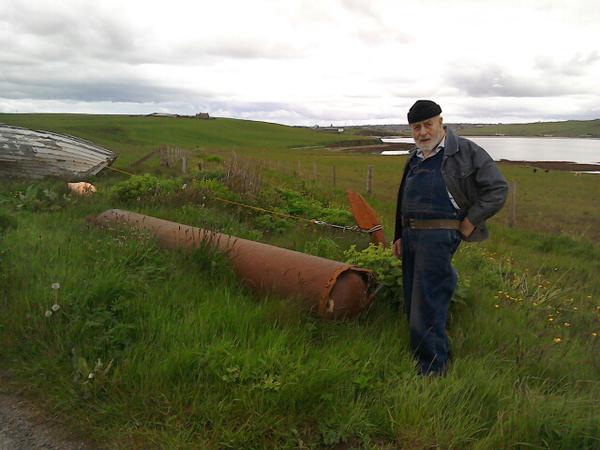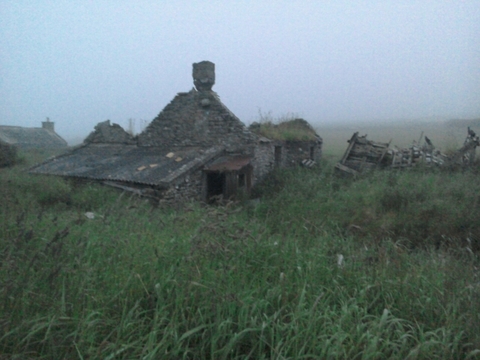Collecting Memories to Record Online
Over the summer months, my colleagues and I have been working on a project called the Orkney and Shetland Community Digital Heritage project. The idea of the project was to get people in Orkney and Shetland involved in collecting memories and stories using digital technology. We are really happy that so many people got involved over these short months. It would have been great if the project were longer, but we are always open to receiving more material even now that the project has officially come to an end.
There were such a lot of positive experiences! I absolutely loved being out and about in the community, meeting with groups of positive and interested people who had memories to share and a curiosity that allowed them to explore the technology. We were using tablets, with a programme called Fieldtrip GB which was developed by Edinburgh University. It connects with the GPS that is built into the device, so that if you take it to a place – an old building for example – it knows where you are and can put you on a map of Orkney. You can then take photos, write about the place, or record your voice as you tell the story of what this place means to you. All that is held together by Fieldtrip GB and put on a website where there is a big map of Orkney and Shetland with lots of pins on it. Each pin point brings up the stories and pictures what people have recorded about that place.
I had some glorious days out with people: A sunny day in Sanday, meeting with the Sanday Afternoon Club, for example. The U3A group in Kirkwall were also involved, as well as Orkney Heritage Society. I walked around in Flotta and cycled around in Papay, taking up a strategic position in the shop to let people know I was there and what I was there for, and boldly knocking on doors. It then snowballed so that once I had spoken to some people, they would suggest who I could contact next. Some people had so much to tell that we could have gone on forever, which was really delightful!
We now have a website where anyone can access the material we collected. To give you a taste of what is there, I have chosen some of my favourite Orkney stories:
In Papay, Jim Rendall had lots of stories to share, including his own memories and folklore stories. One folklore story which got several versions of from various people in Papay was the story of Bothican Castle, which supposedly lies in the Bay of Moclett. It was at one point thought to be a broch, but Christopher Lowe’s research suggested that there had been a mix-up when George Petrie’s drawing of the archaeological remains next to St Boniface church were taken to be Bothican Castle. In any case, as folklore it is still interesting whatever the archaeological reality might be. The designation as a castle is interesting in itself. I was also told that the proper name should be the “Castle of Milliu May” and not Bothican at all (I am trying to spell as it sounds now, but people will no doubt have various spellings for both of these names). Jim Rendall knew that at one time you could see cobbling below the castle at low tide.
In St Boniface Church, on the other hand, there is an old panel which is clearly different from the rest. Jim Rendall said that his mother always told him that this is because that particular panel is made of Spanish Armada wood. The Spanish Armada gold is buried in the one spot in Papay where you can’t see the sea! There are so many exciting Spanish Armada stories in Orkney, and I would love to hear more stories of this kind.

Johnnie Meil (91) from Dyke End in St Ola had a lot of memories to share from the Second World War. He remembered, for example, the night that Isbister by the Brig of Waithe was bombed. Barrage guns were then put all around Scapa Flow to keep bombers away. Johnnie lived by the Scapa Flow shore, and this is how he experienced the barrage: “With all the noise of the barrage, when you put on the wireless for the 9 o’clock news the voice of the presenter faded away and you couldn’t hear it for the thunder of the barrage guns! That was a fair good racket! This went on for a few minutes until the planes went by.”
Johnnie Meil also showed us part of a torpedo, which he had lying in his garden. It had been dredged up from Scapa Flow by people fishing for clams, who had offered it to him, knowing he was interested in that sort of thing.

I got some wonderful glimpses of life in Kirkwall in the 1950s and 60s, walking around town with my mother in law, Kim Foden, who grew up next to the Bignold Park. At that time, there were no other houses around, and from their house they had a view all the way down to Scapa. That is, until the Agricultural Shed for storing County Show equipment was built right in front of their view, which annoyed Kim’s mother no end. The fields were still open all around, though, and Kim enjoyed playing football with her friends. Walking down to school at the newly opened Papdale Infant School and the old Kirkwall Grammar School in what is now the council offices, Kim didn’t have to follow the road, but instead she could cross the fields which led all the way down from the Bignold Park. Kim remembered the County Show as the highlight of the year, which the children looked forward to a lot. She also remembered being a member of the swimming club. As this was before there was any indoor swimming pool in Orkney, the swimming club met at the Kirkwall Basin. However, as it was also before the sewage processing station, you could meet all sorts of things as you swam across the basin …
With Halloween coming up this month, it would perhaps be suitable to end with this chilling ghost story from Flotta, experienced not long ago at a ruined building called The Mill, which was once an inn near the Flotta Kirk, and told by Phyllis Gee: “The Mill was an old ale house run by Captain John Simpson a long time ago. One day not long ago, Margaret who is a new resident in Flotta was out walking her dog when she came past here and heard a strange scraping noise from the house. The dog seemed worried. She looked in to see what it was and saw a man moving tables, dragging them along the floor, although she knew the building to be derelict. A couple of years later I found a photo of John Simpson and put it up in the shop for interest and Margaret came in and said: That's him! That's the man I saw!”

These are just some examples of the stories we recorded in the Digital Heritage project. We were interested in everything from “unofficial” place names, to little snippets of information, to folklore, to personal memories. There is also material from Shetland, as our colleagues in Shetland have been doing the same there. If you would like to see more, you can go to http://digital.norseworld.com/
Even though our short project is finished for now, we can still add more material to the website. We are also exploring further funding options with a view to carrying on. So if you have stories to share, we would still be very happy to hear from you.
Ragnhild Ljosland, Originally published in The Orcadian 15 October 2015